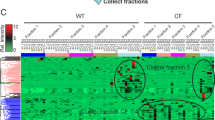Abstract
In nature, the urn cell complexes which swim in the coelomic fluid of the marine invertebrate,Sipunculus nudus, produce “tails” of mucus in response to bacterial pathogens. Since they produce measurable tails of mucus in vitro, suspensions of urn cell complexes provide a bioassay for mucus-stimulating substances (MSS) in biological fluids, including several human body fluids. Heat-activated seawater dilutions of human serum contain MSS.
Serum from 87 cystic fibrosis (CF) homozygotes, 60 obligate heterozygotes, and 45 controls were fractionated on a Sephadex G-200 gel filtration column. After subsequent heating for 4 min at 85°C, the fractions of all normal sera showed two characteristic peaks of MSS activity.
The pattern differed in heated serum fractions of CF patients, in that the second peak was lacking in 59% of individual tests. The pattern was intermediate in heterozygote sera. Of the 36 CF serum fractions which did have two peaks of activity, 89% had the predominant activity in peak 1. The frequency of single peaks of activity increased with patient age, from 33% in those under 10 years to 75% in those over 16. The molecular weight of peak 1 is about 75,000 daltons, of peak 2 about 30,000.
One may speculate that the frequent lack of peak 2 serum components may be associated with the inability of most CF patients to produce normal mucus following respiratory infection.
Similar content being viewed by others
References
Bang BG, Bang FB (1972) Mucous hypersecretion induced in isolated mucociliated cells by a factor in heated serum. Am J Pathol 68: 407:418
Bang BG, Bang FB (1974) Invertebrate model of study of macromolecular regulators of mucus secretion. Lancet 2:1292–1298
Bang BG, Bang BG (1979) Mucus-stimulating substances in human body fluids assayed in an invertebrate mucous cell system. Johns Hopkins Med J 145:209–216
Bang FB, Bang BG (1980) The urn cell complex ofSipunculus nudus: a model for study of mucus-stimulating substances. Biol Bull 159:264–266
Bang FB, Bang BG (1962) Studies in Sipunculid blood: Immunologic properties of coelomic fluid and morphology of ‘urn cells’. Cahiers Biol Mar 3:363–374
Bang FB (1966) Serologic response in a marine worm,Sipunculus nudus. J Immunol 96:960–972
Berninger RW (1983) Personal communication
Cantacuzène J (1922) Réactions d'immunité chezSipunculus nudus vacciné contre une bactérie. Comptes Rendus Soc Biol 87: 264–266
Franklin RW, Bang BG (1980) Mucus-stimulating factor in tears. Investig Ophthalm Vision Soc 19:430–432
Ishizaka T, Ishizaka K (1959) Biological activities of aggregated gamma globulin. I. Skin-reactive and complement-fixing properties of heat-denaturated gamma globulin. Proc Soc Exp Biol Med 101:845–850
Kretzinger RH (1976) Evolution and function of calcium-binding proteins. Internat Rev Cytol 46:323–393
Kulemann-Kloene H, Krag SS, Bang FB (1982) Mucus secretion stimulating activity in human lymphoblastoid cells. Science 217:736–737
Kurlandsky LE, Berninger RW, Talamo RC (1980) Mucus-stimulating activity in the sera of patients with cystic fibrosis: Demonstration and preliminary fractionation. Pediatr Res 14:1263–1268
Littlewood JM, Congdon PJ, Breece G, Kelleher J, Rothburn M, Losowsky MS, Clarke PCN (1980) Vitamin status in treated cystic fibrosis. In: Sturgess J (ed) Perspectives in cystic fibrosis. The Imperial Press, Ltd, Missisauga, Ontario, Canada, pp 166–171
Nicosia SV (1979) Lectin-induced mucus release in the urn cell complex of the marine invertebrateSipunculus nudus (Linnaeus). Science 206:698–700
Silverman BA (1981) Etiology and experimental production of mucoid enteritis of rabbits—Correlation of urn cell activity and the clinical course of the disease. Doctor of Science thesis. The Johns Hopkins University School of Hygiene and Public Health, Baltimore, Maryland, USA
Smith ER, Underwood DA, Denny CR, Varma A, Goodman DS (1980) Depressed plasma retinol binding protein levels in cystic fibrosis. J Lab Clin Med 72:423–435
Author information
Authors and Affiliations
Additional information
The investigations were supported by NIH grant no. 1 P50 HL-19157
Rights and permissions
About this article
Cite this article
Bang, B.G., Bang, F.B. & Failla, J.M. Differences in mucus-stimulating serum fractions of cystic fibrosis patients and controls. Eur J Pediatr 140, 22–26 (1983). https://doi.org/10.1007/BF00661899
Received:
Accepted:
Issue Date:
DOI: https://doi.org/10.1007/BF00661899




